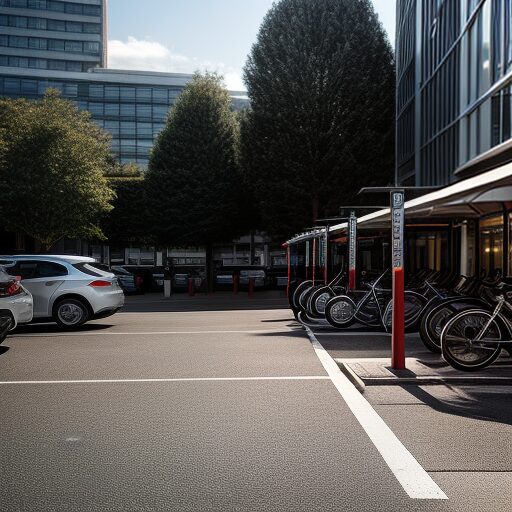In Conversation With: Richard King
How are Airport Parking Requirements Changing?
This week we are in conversation with Richard King, Senior Business Development Manager focussing on operator and airport customers. We are talking about airports.
We know a major part of airport income is through the parking services they offer – drop off outside the terminal, short stay in the immediate vicinity, long term on the outskirts of the airport, as well as staff parking, taxi services, bookings, VIP, and meet & greet services. These services give the airport visitors everything they need to start their journey in the best way available for them.
I wanted to discuss how airport parking has changed since covid restrictions on travel and find out what the future holds for parking services.
Before we get into where we are and where you see it going, we need to get an overview of our starting point. It’s 2019, what does airport parking look like?
In 2019, the landscape of airport parking was designed to prioritise customer comfort and ease, extending this ethos particularly to the sprawling territories of airport car parks. The overarching goal was always to elevate the overall travel experience for passengers, ensuring a seamless and stress-free beginning to their journey. However, the methods employed to achieve this objective back in 2019 were characterised by a hardware-heavy environment.
During this period, airport parking was defined by a multitude of barriers strategically positioned throughout parking facilities, along with numerous cash payment machines scattered across the car parks. This hardware-centric approach, while aimed at providing convenience, inadvertently resulted in a complex infrastructure with an abundance of moving parts. The prevalence of barriers and payment machines not only created an expectation but also became an industry standard, shaping the parking experience for travellers.
In some airports, the reliance on such hardware was so substantial that engineers found themselves stationed on-site continuously, engaged in the constant upkeep and maintenance of the intricate system. Cash pay machines were omnipresent, and barriers were a ubiquitous feature at every entry and exit point, aligning with the industry’s expectations.
While the commitment to enhancing the traveler’s experience remained unwavering, the methods of achieving this goal were firmly anchored in a hardware-heavy product environment. The industry operated under the assumption that widespread hardware installations were essential to meet the perceived expectations of convenience and security. Little did we know that significant shifts were on the horizon, reshaping the very foundations of airport parking in the years to come.
It was all about hardware, making sure airport visitors could pay pretty much everywhere. Coming out of covid, how did that change?
Covid changed the airport parking industry. I remember talking to one of our engineers on site who was upgrading the entire airport during the day; which was and still is, completely unheard of. He said there were two cars in the entire car park, and one of those was his. There were thousands of spaces in that car park, and we were the only ones there. That one chat really confirmed how much the industry would change. And it did.
Coming out of covid, there was a huge focus on getting passengers travelling again; and subsequently getting passengers back into the car parks. In the immediate weeks after the lockdowns, it was about making sure everything was working. Getting all our services completed and making sure all the hardware and software was in perfect working order.
In the months after lockdown and in the slightly longer term, we were talking about cost, maintenance and making sure the solutions we had in place were the right solutions for airport visitors moving forward. We were actually talking a lot about keeping everything working. Before covid, there were funds available for upgrades. Now, it was all about making current systems go further. What could we do to keep things working. There had been a massive drop in revenues, and where previously upgrades were generally like for like replacements where the incumbent provider was in a great position, the airports reduced what they could do. That meant smaller projects, targeted at what was needed in the short term, rather than total upgrades.
So, shorter term needs were the requirement at the time. What is happening now with airport parking?
It’s an evolving landscape and there are transformative shifts taking place. There is a real trend towards airport-led services, emphasising the increased collaborations with third-party providers instead of relying solely on proprietary solutions. This approach is aimed at enhancing the overall visitor journey by integrating innovative services and hardware solutions precisely where they are needed.
One notable development is the emergence of new players in the market, particularly those solely focusing on apps and barrier-free solutions. This single minded focus though, I think, is just too narrow. We must redefine the parking experience by prioritising the visitor journey, adding services and hardware where we need to. There is also a conscious effort to shift focus from competition to collaboration, concentrating on enriching the visitor experience rather than solely on system upgrades.
There is now a new complexity because of the heightened competition. With airports seeking better value in their parking solutions, there is a shift from a one-size-fits-all approach to tailoring options for different types of visitors. The emphasis is no longer on a mere replacement of existing systems but on providing comprehensive solutions that offer airports easy management, efficient reporting, and simplified maintenance.
Speaking about the challenges brought about by this changing landscape, we need to underscore the importance of maintenance as a key focal point. Airports are now striving for fewer hardware components, resulting in reduced hardware support needs. This shift towards a leaner infrastructure also means more systems are online, necessitating seamless integrations, robust connectivity, and cloud-based support. These challenges should not be seen as obstacles but as opportunities that make the job more engaging and dynamic.
What’s next? What are we going to see in the next 5 years?
There has been a central theme for a number of years of adaptability. Airports have successfully navigated the circumstances they have been in, from pre-covid, through covid to the current post-covid era, and they are now strategically shaping the future.
Looking ahead, there are two paramount factors that will significantly shape airport parking requirements: a heightened focus on visitor experience and robust support systems. Notably, these aspects have already been gaining attention in recent years and are expected to take centre stage in the years to come.
The intensified focus on visitor experience and support will be the driving force behind the industry’s evolution. This shift will go beyond traditional parking services, where we envision a future where airports become integral components of a larger partner-driven ecosystem. This collaborative approach will involve various stakeholders, including booking platforms, parking systems, enforcement mechanisms, visitor engagement initiatives, and EV charging solutions.
I can see a continuation of the current trend towards a more holistic and interconnected system, where each element seamlessly fits into the broader visitor journey. It’s vital that we are part of this evolving ecosystem, contributing to the collective effort in enhancing the visitor experience.
Furthermore, the vision is for airport parking becoming a key element in the broader partnership, ensuring that their role is specialised yet integrated. It is important as an industry that our contribution counts within the broader network of services, ensuring a seamless and efficient part of the overall travel experience.




